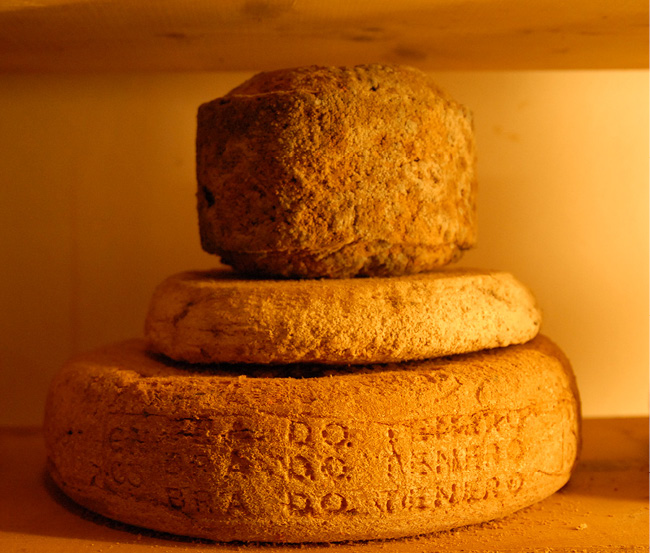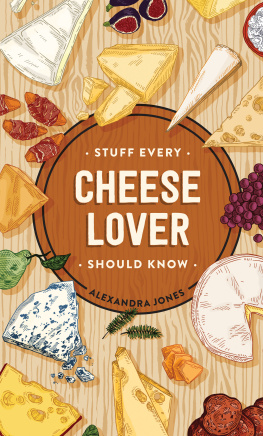Title Page
101 AMAZING FACTS ABOUT CHEESE
Jack Goldstein
Publisher Information
Published in 2014 by
Andrews UK Limited
www.andrewsuk.com
The right of Jack Goldstein to be identified as the author of this work has been asserted by him in accordance with the Copyright, Designs and Patents Act 1998
Copyright 2014 Jack Goldstein
All rights reserved. No part of this publication may be reproduced, stored in a retrieval system, or transmitted, in any form or by any means without the prior written permission of the publisher, nor be otherwise circulated in any form of binding or cover other than that in which it is published and without a similar condition being imposed on the subsequent purchaser. Any person who does so may be liable to criminal prosecution and civil claims for damages.
All facts contained within this book have been researched from reputable sources. If any information is found to be false, please contact the publishers, who will be happy to make corrections for future editions.
Introduction
Do you know which cheese is the most expensive in the world? Or why cheese made in the village of Stilton can no longer be called Stilton cheese? How large was the wheel of Cheddar given to Queen Victoria as a wedding present? And what was Napoleons favourite cheese? All these questions and more are answered in this fascinating book. Whether you are an experienced cheese buff and want to discover some interesting and little-known facts, or you just want an introduction to the process of cheesemaking, this is an excellent addition to your bookshelf.
Follow Jack Goldstein on Twitter @GoldsteinBooks
Visit Goldstein Books at www.jackgoldsteinbooks.com
The Basics
- The word cheese comes from the Latin caseus; in early English this became caese, and in the middle ages chese, eventually leading to the cheese we know today.
- The French word for cheese is fromage - this comes from the Latin Caseus formatus - moulded cheese which was carried by soldiers of the Roman army.
- Cheese is generally considered to be in one of three categories - hard, soft or runny.
- France and Italy can both boast around 400 different cheeses each.
- A specialist retailer of cheese is called a cheesemonger.
- Cheese is an important source of vitamin B12, essential for the formation of new red blood cells.
- When eating a range of cheeses, one should start with the mildest, working your way up to finish with the strongest.
- Most cheese is designed to be served at room temperature; this is when it shows its intended texture and flavour.
- At the very bottom of a fondue, youll find a thin layer of cracker-like toasted cheese. This has various names across the world, from the nun in Britain to Frances la religieuse and Germanys grossmutter . It is considered to be a particularly tasty part of the fondue experience, so perhaps these names indicate who it is saved for - the nuns of Britain or Germanys grandmothers... and the French may be describing eating it as a religious experience!
- There is a traditional myth which says that the moon is made from green cheese. The word is actually written as greene in the earliest source text we can find ( The Proverbs of John Heywood from 1546) and is now thought to refer to the cheese being new or un-aged as opposed to being coloured green.

Maturing Cheeses
Facts and Figures
- It takes about ten litres of milk to make just one kilogram of hard cheese.
- The world cheese is used just twice in the King James Bible - in 1 Samuel and 2 Samuel; cheeses is used just once - in the book of Job.
- According to a study, the perfect thickness of cheese for a sandwich varies with type - from just 2.5mm for double Gloucester to a whole 7mm for Wensleydale.
- Cheese consumption in the US has tripled since 1970.
- Around 90% of cheese sold in America is classified as Cheddar cheese.
- Despite this, the most frequently eaten cheese in America is actually mozzarella - pizza lovers have ensured this has grown massively in popularity over the last 20 years.
- Over 700 different regional cheeses are produced in the UK alone.
- Cheese is an excellent source of calcium, an essential mineral for the development of our bodies. Around one child in every six has a daily calcium intake lower than the recommended amount.
- The nutritional breakdown of cheese varies greatly with type; cottage cheese for instance contains around 4% fat whilst common cheeses such as cheddar can contain over 30% fat!
- Although cheese has not historically been popular in east Asian countries, it is now catching on. Cheese consumption doubled in China between 1996 and 2003!

A Classic Italian Pizza, Made with Mozzarella
Cheese in History
- It is thought that the production of cheese dates back as far as 8000BC, around the time that sheep were first domesticated.
- It is likely that cheese was discovered by nomadic tribes in the middle east who would have stored milk in animal hides where it would have naturally separated into curds and whey by the combination of natural bacteria and the movement of the hides when they were carried around.
- The earliest archaeological evidence of cheesemaking we have is found on the walls of Egyptian tombs dating back to 2000BC.
- Early cheese in Africa and the Middle East would have been very different to most types today. To stop it from going off in the hot environment, a great deal of salt would have been needed to preserve it, making the taste extremely sour. It was not until cheesemaking spread to Europe that the cooler conditions allowed cheeses to age, thus giving us a greater range of flavours.
- In Homers odyssey you will find a passage where he describes the Cyclops making and storing cheese - particularly from sheep and goats milk.
- Plinys Natural History, written in 77AD, has a whole chapter devoted to describing the cheeses enjoyed by the Roman populace from all corners of their empire. In his opinion, the best cheeses came from Nimes, although they tended to go off quickly.
- Large Roman houses actually had a special room just for making cheese, known as the careale .
- In the sixteenth century, strong stilton was often served with a special spoon for scooping out maggots.
- Napoleon Bonaparte was particularly fond of Epoisses cheese from the Burgundy region in France.
- The first actual cheese factory (rather than local farmers producing small batches) was set up in New York in 1851 by Jesse Williams.

Storage of Cheese Wheels
Cheese Production
- Cheese is made by the coagulation of the protein casein in milk.
- The process is achieved by adding the enzyme rennet to the milk
- The milk is separated into curds (the solid part which forms the cheese) and whey (the liquid part) - this is known as curdling.
- Most cheeses are acidified as part of the production process, either by natural methods (bacteria turning the milk sugars into lactic acid) or by the manual addition of additives such as vinegar or lemon juice.
- Most cheese in the English-speaking world is made from cows milk, however it is common across the world to use many other animals milk - including buffalo, sheep and goat.
Next page













